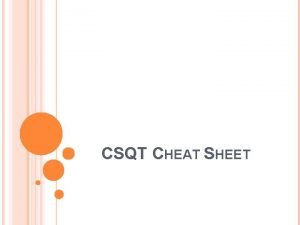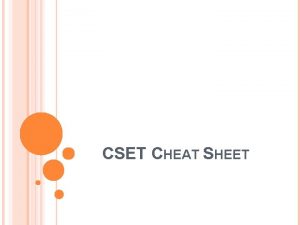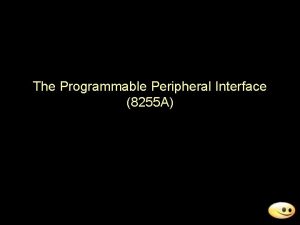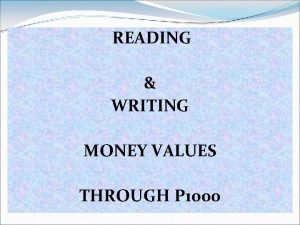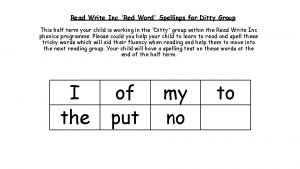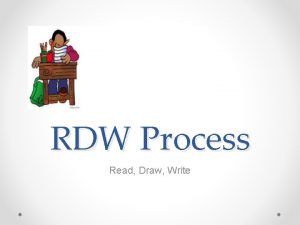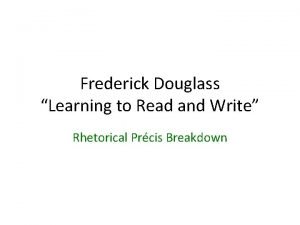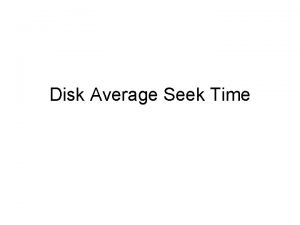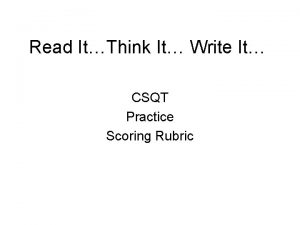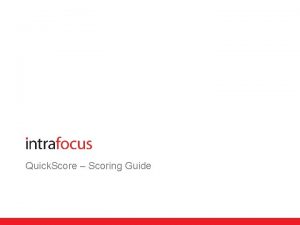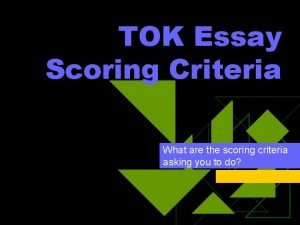Read ItThink It Write It CSQT Practice Scoring













- Slides: 13

Read It…Think It… Write It… CSQT Practice Scoring Rubric

C. S. Q. T. Background • Method/formula for answering questions that helps you remember and organize key information needed for an excellent response (paragraph framework). • Reinforce a key skill: learning to use quotes AND explaining, spinning, shaping them in order to back your claims. • Good argument skills = better grades and increased ability to more fully participate in the great debates of our democracy.

C. S. Q. T Claim – The answer to the question. Often you can use part of the question to formulate your claim. Set-up – Introduce the quote to be used—contains information about the quote. Quote – The textual reference that supports your claim. Tie-In – Explain how the Quote proves your Claim. Often this section is two or more sentences. First explain the quote and then it’s connection to the Claim.

Making a Claim Your claim is what you will try to prove through your answer. In a one paragraph answer, the claim is your topic sentence. In a longer essay, the claim is your thesis sentence. A thesis is what you intend to prove through your essay.

Setting Up the Quote • The set-up simply provides a transition from your claim to your quote. It does NOT have to be a complete sentence; it can be a transitional phrase. – The article states, – The author says, – Paragraph three shows this by stating, • Be sure to include the quote word for word from the text. Include quotation marks at the beginning and end of the text.

Including the Quote • Choose a quote that supports your claim. • Be sure your readers can tell who wrote the quote. You can – Include the author’s name in your set-up sentence: According to Smith, “Quote. ” OR – Include the author’s name in parenthesis after the quote. For example: “Quote, ” (Smith). • FYI—A quote is any exact text you copy from an author.

The Tie-In • The tie-in is the most important part of your answer. It provides your reader with the explanation for your claim. • Be sure that the quote you pick actually supports your answer • EXPLAIN the meaning of the quote (you may have to explain how it fits in the story, etc. , or other info to help the reader) • Finally, explicitly explain how the quote fits the claim!

Peer Editing Rubric Excellent Claim Set-Up Quote Tie-in Good Needs Work The CLAIM about the passage of literature is clearly stated and is very logical given what we know about the piece of literature. The CLAIM about the passage of literature is mostly clear and logical given what we know about the piece of literature. The CLAIM about the passage of literature is unclear or not logically related to the piece of literature. The SET-UP clearly explains the context for the author’s quote (where it is from, and what is going on) so that the reader knows exactly what the quote is about. The SET-UP explains a little bit about what is going on in the quote so that the reader mostly knows what the quote is about. The writer either does not set-up the quote (goes right into the quote after the claim) or does not clearly explain what the quote is about. The QUOTE clearly relates to the writer’s CLAIM. The QUOTE sort of relates to the writer’s claim but a better choice could be made. The QUOTE does not relate to the writer’s claim very well. The TIE-IN specifically explains why the quote proves the author’s claim without simply repeating the quote. The TIE-IN may also give two reasons that the quote proves the author’s claim. The TIE-IN explains why the quote proves the author’s claim but may be a bit repetitive or unclear. The TIE-IN does not explain why the quote proves the author’s claim or is unrelated to the quote or claim.

Practice The cold harsh wind it heaves and blows, It chills my fingers and my toes. And falling from the sky of slate, A dancing whirr of downy flakes. The flakes that dance, and whirr and fly, They sometimes hit me in the eye. Seeing them again I clap with glee, Ha Ha, Hee Hee. Don’t go to that shopping mall! It is the season after fall! And when you get at home in bed, Thoughts of frost they fill your little mind! -Anne Uhhuhmelmahey 1978

Practice Prompts: • Using the CSQT format, what season is being described in the poem? • Using the CSQT format, what is the narrator’s mood?

Sample Answer The season that is described in the poem is winter. In the beginning of the poem Uhhuhmelmahey describes a heaving wind that “chills her fingers and her toes, ” and later goes on to say that she sees “a dancing whirr of downy flakes. ” Since the poet describes a brutally cold wind that flings flakes that most likely is snow, the poem is probably set during the winter when snow and cold are regular occurrences.


"Waiting On The World To Change" By John Mayer Now if we had the power To bring our neighbors home from war They would have never missed a Christmas No more ribbons on their door Now we see everything that's going And when you trust your television wrong What you get is what you got With the world and those who lead Cause when they own the information, it They can bend it all they want We just feel like we don't have the means It's not that we don't care, To rise above and beat it We just know that the fight ain't fair So we keep on waiting So we keep waiting Waiting on the world to change We keep on waiting One day our generation Waiting on the world to change Is gonna rule the population So we keep on waiting It's hard to beat the system Waiting on the world to change When we're standing at a distance So we keep waiting Waiting on the world to change For what generation is this song Me and all my friends We're all misunderstood They say we stand for nothing and There's no way we ever could intended? Use text to support your answer!
 Csqt
Csqt Cset cheat sheet
Cset cheat sheet Csqt writing
Csqt writing Score script
Score script Talk, read talk write template
Talk, read talk write template How many bit data bus buffer is used in 8255
How many bit data bus buffer is used in 8255 Reading and writing money
Reading and writing money Read write inc hand signals
Read write inc hand signals Red words read write inc
Red words read write inc How to write 115 on a check
How to write 115 on a check Rdw math process
Rdw math process Learning to read and write frederick douglass audience
Learning to read and write frederick douglass audience Read and answer write in your notebook
Read and answer write in your notebook Delay elements in disk read or write
Delay elements in disk read or write
